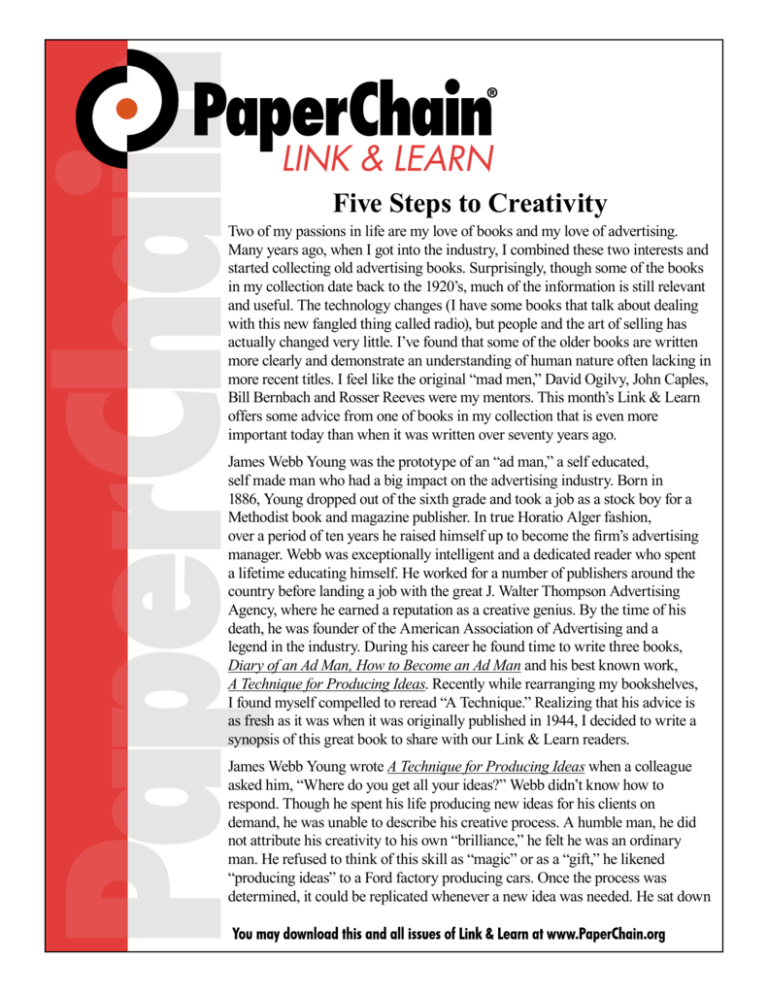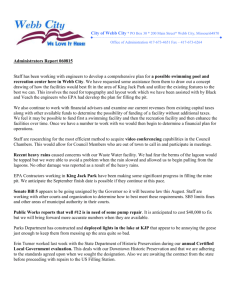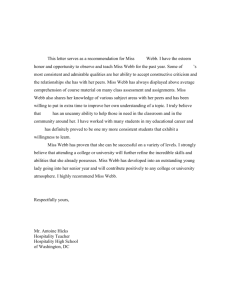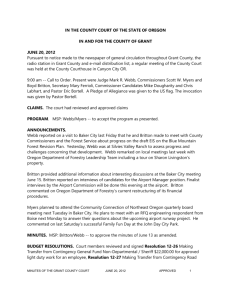Five Steps to Creativity
advertisement

Five Steps to Creativity Two of my passions in life are my love of books and my love of advertising. Many years ago, when I got into the industry, I combined these two interests and started collecting old advertising books. Surprisingly, though some of the books in my collection date back to the 1920’s, much of the information is still relevant and useful. The technology changes (I have some books that talk about dealing with this new fangled thing called radio), but people and the art of selling has actually changed very little. I’ve found that some of the older books are written more clearly and demonstrate an understanding of human nature often lacking in more recent titles. I feel like the original “mad men,” David Ogilvy, John Caples, Bill Bernbach and Rosser Reeves were my mentors. This month’s Link & Learn offers some advice from one of books in my collection that is even more important today than when it was written over seventy years ago. James Webb Young was the prototype of an “ad man,” a self educated, self made man who had a big impact on the advertising industry. Born in 1886, Young dropped out of the sixth grade and took a job as a stock boy for a Methodist book and magazine publisher. In true Horatio Alger fashion, over a period of ten years he raised himself up to become the firm’s advertising manager. Webb was exceptionally intelligent and a dedicated reader who spent a lifetime educating himself. He worked for a number of publishers around the country before landing a job with the great J. Walter Thompson Advertising Agency, where he earned a reputation as a creative genius. By the time of his death, he was founder of the American Association of Advertising and a legend in the industry. During his career he found time to write three books, Diary of an Ad Man, How to Become an Ad Man and his best known work, A Technique for Producing Ideas. Recently while rearranging my bookshelves, I found myself compelled to reread “A Technique.” Realizing that his advice is as fresh as it was when it was originally published in 1944, I decided to write a synopsis of this great book to share with our Link & Learn readers. James Webb Young wrote A Technique for Producing Ideas when a colleague asked him, “Where do you get all your ideas?” Webb didn’t know how to respond. Though he spent his life producing new ideas for his clients on demand, he was unable to describe his creative process. A humble man, he did not attribute his creativity to his own “brilliance,” he felt he was an ordinary man. He refused to think of this skill as “magic” or as a “gift,” he likened “producing ideas” to a Ford factory producing cars. Once the process was determined, it could be replicated whenever a new idea was needed. He sat down and began analyzing his own creative process and talked to other creative people in business and the arts to discuss theirs. Young’s work led him to identify a five step process for “Producing Ideas.” His methods have been verified by modern research into how the brain functions and the creative process. In an age where offering our advertisers new and creative ways to promote their products, James Webb Young’s technique is critical not only to our success, but to our very survival. James Webb Young divided the world into two kinds of people: “speculators” and “rentiers.” Speculators, in this context, refers to people who are “constantly pre-occupied with the possibilities of the situation.” He describes them as “reconstructors of the world,” and as people who can’t let well enough alone. Never satisfied, they are always looking for a way to make things better. On the other hand, rentiers, a French term which literally means “stockholder,” are conservative in that they resist change. They are comfortable with the status quo, preferring to leave things as they are. Young felt that “speculators” were responsible for all advances in business, science and the arts. He believed that with training and coaching anyone could become a “speculator.” Young’s Five Step Process Step 1: Gather Material—James Webb Young wrote, “An idea is nothing more or less than a new combination of old elements.” He felt that the more “elements” you had to work with, the more ideas you could produce. He said that an advertising professional needed to collect two kinds of information, “general” and “specific.” Collecting general information is a never ending task. He felt that the first step to creativity is curiosity. He encouraged his readers to be curious about everything and anything; to collect information from a broad range of subjects and interests. The more random facts you have stored away in your brain, the larger number of combinations, i.e. new ideas, you will be able to produce. When presented with a problem, you should begin collecting specific information. In advertising, you need to learn as much as possible about the product you are selling and the client you are representing. You also need to learn everything you can about the customers who are likely to buy the product. This will enable you to see areas where you can bring the two together to satisfy the needs of both buyer and seller. Step 2: Digest the material—Young knew that individual facts are meaningless; that new ideas stem from seeing the relationships between isolated facts and concepts. He likened the creative process to a child’s kaleidoscope. That we should keep turning over all of the information we’ve gathered over and over in our minds. Working in the dark ages before computers, James Webb Young collected his facts on 3” X 5” index cards, arranging them by category. While we have access to modern technology and searchable databases, there is something to be said for Young’s old school methods. Writing the information on the cards and shuffling through them engages different parts of the brain. Physically handling the cards slows the process down and may help you to see relationships that you might miss on a computer screen. You should write down every idea that pops into your head, no matter how outlandish. Your “wild” ideas may be the seed of a practical solution. Young emphasized that this is the most difficult part of the process. He agreed with his friend Henry Ford’s statement, “Thinking is the hardest work there is, which is probably why so few people engage in it.” He encouraged his readers to look at the problem from every angle and to stick to it until you’re sure you’ve considered all the possibilities. Step 3: Incubation stage—This is by far the easiest of Young’s process. Once he was sure he had thoroughly considered the problem; he would “drop it.” He would go to bed, take a walk or move on to some unrelated task. This allows your unconscious to go to work. Today psychologists talk about system 1 (conscious) and system 2 (unconscious) thinking. Young’s method allows your more creative system 2 to come up with an ideawithout interference of the self critical system 1. Step 4: Birth of an idea—If you’ve done the hard work of collecting and analyzing the information available to you and then shut down your conscious brain allowing your unconscious to go to work, the idea you’re looking for will pop into your brain fully formed. This is something like the old show business joke, “it takes ten years to become an overnight success.” There is a mythology about the creative process, that great ideas simply come to creative people like a flash of lightning. This myth arose because casual observers did not see the hard work and deep thought that went into the process. Step 5: Refining the idea—James Webb Young was not an inventor working alone in a basement somewhere. He spent his career working inside large organizations; he knew the value of soliciting the opinions of others. He advised creators not to be overprotective of their ideas. He felt that good ideas became great ideas through exposure to criticism. He understood that others may see something he had missed in the creative process. James Webb Young believed that truly great ideas had “self expanding properties” stimulating others to develop their own creative solutions. SM Conclusion This column is just a synopsis of this powerful little book (my 1956 edition runs just 61 pages). If you are interested in reading it for yourself, A Technique for Producing Ideas is still in print. At this writing, new copies were available on Amazon for $5.35. It is written in a simple, direct easy to read style. I first read mine in about an hour, and have reread it many times since. Many people consider me a “very creative person.” I owe this reputation to James Webb Young and his 5 steps. Though James Webb Young died in 1973, two years before the founding of Microsoft and three years before Apple opened for business, his ideas have a place in the 21st century. The ability to develop fresh new ideas for our customers is the ultimate competitive advantage. With the spirit of James Webb Young by our side, we will be able to come up with creative solutions that will keep our customers happy and our publications strong far into the future. This article was written by Jim Busch of the Pittsburgh Pennysaver. Link & Learn is brought to you every month as part of PaperChain’s® mission to provide educational material to the free paper publishers. If you have an issue you would like to see covered please email janderson@wisad.com, put “Link & Learn” in subject line. Be sure to check out www.paperchain.org for past issues, electronic ready promotional ads and much more to help you remain competitive.





